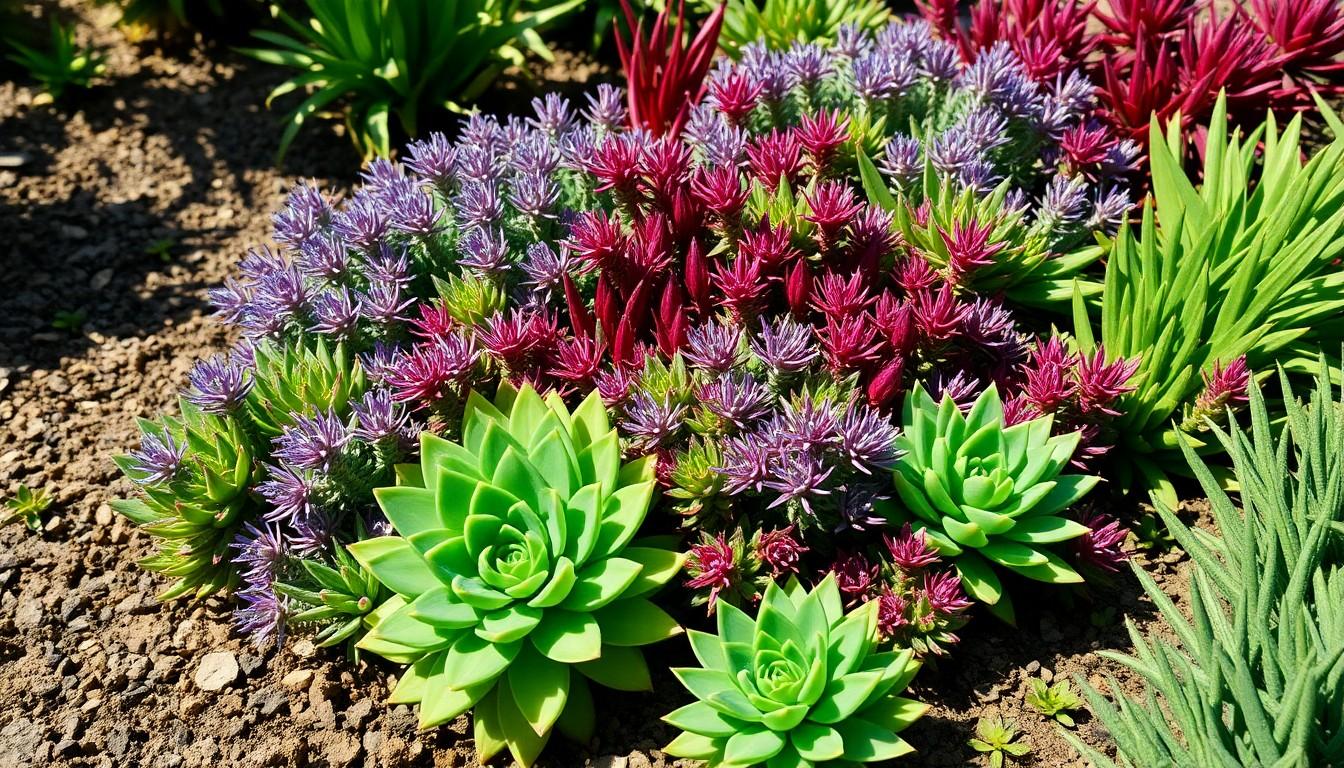
If you’re looking to add a splash of personality to your garden, hens and chicks are the perfect candidates. These charming little succulents not only thrive on neglect but also bring a delightful touch of whimsy to any space. With their rosette shapes and vibrant colors, they’re like the cool kids of the plant world—low-maintenance and always ready to impress.
Hens and Chicks
Hens and chicks, scientifically known as Sempervivum, belong to the Crassulaceae family. These succulents display a unique rosette shape, capturing attention in gardens and containers alike. Many gardeners appreciate their vibrant colors, which range from green to deep red. These variations create lively arrangements in various settings.
Adaptability characterizes hens and chicks. They flourish in diverse environments, from rocky outcrops to garden beds, with little care. These plants thrive in well-draining soil, minimizing the risk of root rot. Direct sunlight boosts their growth, making a south-facing location ideal.
Propagation is straightforward, particularly through offsets. These offsets, or “chicks,” emerge around the parent “hen,” providing an easy way to expand a collection. Removing these offsets encourages new growth in the original plant, promoting a healthy lifecycle.
Watering practices focus on minimal intervention. Allowing the soil to dry between watering prevents over-saturation. During the growing season, a biweekly watering schedule suits most climates. In contrast, winter months require less frequent watering since the plants enter dormancy.
Pest issues remain infrequent with proper care. Aphids or mealybugs may appear, yet they pose minor threats. Employing organic insecticidal soap eradicates pests effectively without damaging the plant.
Overall, hens and chicks create an enchanting addition to gardens, reflecting resilience and charm. Their low-maintenance nature enhances sprawling landscapes, making them a favorite among both novice and experienced gardeners.
Plant Characteristics

Hens and chicks exhibit distinct features that contribute to their popularity among gardeners.
Types of Hens and Chicks
Sempervivum comprises numerous species and cultivars, each displaying unique characteristics. Varieties such as ‘Green Globe’ showcase vibrant green hues, while ‘Black’ presents dark, rich tones. ‘Purple Beauty’ captivates with its striking purple display, and ‘Cherry Truffle’ adds a touch of red. Gardeners often choose specific types based on desired aesthetics and garden themes.
Growth Habits
Hens and chicks thrive in various environments, demonstrating remarkable adaptability. These plants form dense mats of rosettes, often spreading over time. Typically, they grow in clusters, surrounding a central “hen” plant with “chick” offsets. During the growing season, they flourish, producing flowers that rise above the foliage. Many prefer well-draining soil and full sunlight, leading to robust growth and color retention.
Hens and Chicks Plant Care
Hens and chicks thrive in specific conditions that support their growth and resilience. Proper care involves attention to sunlight, watering, and soil, ensuring these succulent plants flourish.
Sunlight Needs
Bright, direct sunlight promotes healthy growth in hens and chicks. These plants require at least six hours of sunlight daily to maintain vibrant colors and robust structures. Reduced sunlight can lead to leggy growth, diminishing their appearance. Positioning these plants in a south- or west-facing garden spot enhances their exposure. Container arrangements can also optimize light absorption. This adaptability allows them to thrive in various environments.
Watering Tips
Watering practices for hens and chicks center on dryness. Soil should dry thoroughly between waterings, particularly during winter dormancy. Overwatering leads to root rot, which jeopardizes plant health. As a general guideline, check soil moisture weekly during the growing season. In cooler months, reduce watering to every few weeks, depending on humidity levels. Effective drainage assists in preventing excess moisture retention and promotes longevity.
Soil Preferences
Soil requirements for hens and chicks hinge on drainage. A well-draining soil mix ensures optimal conditions for growth, preventing root issues. Ingredients like cactus mix or a combination of potting soil with sand or perlite support drainage. This blend allows roots to breathe while retaining minimal moisture. The ideal pH ranges from 6.0 to 7.0, accommodating most varieties. Regularly checking soil composition maintains plant health, fostering vibrant rosettes and overall vitality.
Common Issues and Solutions
Hens and chicks may occasionally face challenges, but solutions exist for effective care.
Pests and Diseases
Aphids and mealybugs can pose threats to hens and chicks. Regular inspections help identify infestations early. Using organic insecticidal soap effectively manages these pests. Root rot also presents a risk, primarily due to overwatering. Signs of rot include mushy leaves and a foul odor. Draining excess water and adjusting watering practices prevent such issues.
Environmental Stressors
Hens and chicks thrive in full sunlight but may struggle in extreme temperatures. Excessive heat can lead to sunburn or leaf wilting. Providing partial shade during peak afternoon hours protects plants. Additionally, insufficient water can stress these succulents. Recognizing signs like shriveled leaves signals the need for increased moisture. Consistent care ensures these plants remain vibrant and healthy despite environmental challenges.
Brings Charm And Resilience to Any Garden
Caring for hens and chicks is a rewarding experience that brings charm and resilience to any garden. Their low-maintenance nature makes them ideal for both novice and experienced gardeners. With the right sunlight and watering practices, these succulents can thrive beautifully.
By understanding their unique needs and characteristics, gardeners can effortlessly expand their collections and enjoy vibrant displays. Regular monitoring for pests and environmental conditions ensures that these delightful plants remain healthy and colorful. Embracing the whimsical nature of hens and chicks adds a touch of personality to outdoor spaces, making them a cherished addition to any garden.
